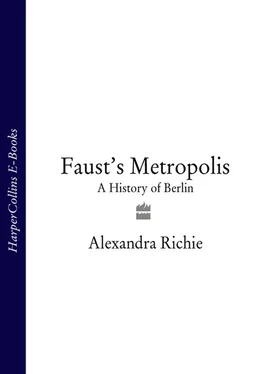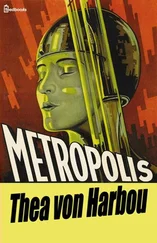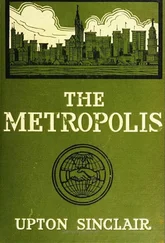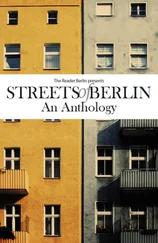The amount of work already undertaken by the late 1990s would have astounded even the nineteenth-century commentators; the sheer number of cranes – which have been decorated, photographed and even synchronized to move up and down to music – is staggering. Berlin is presently a DM50 billion construction zone filled with piles of earth and iron girders and cement trucks and arc lights and populated with Polish and Irish labourers (locals are too expensive). By August 1997 30 million tons of gravel had been poured, 70 million cubic feet of water pumped out for foundations, road and rail tunnels, and 17,411 trees had been planted – even the river Spree had been temporarily redirected to allow for the work near the Reichstag. The budget signed on 30 June 1994 provided DM2.8 billion merely to move the parliament while an estimated DM20 billion has been earmarked for the improvement of the transportation and communications infrastructure. ‘Berlin, the City’ has become the greatest millennium project in Europe. Local kiosks, bookshops and tourist stands are stuffed with brightly coloured maps which extol the virtues of the ‘new Berlin’; one sells the ultimate guide to Pläne und Kräne (Plans and Cranes); another advertises Der Tagespiegel under a picture of a construction site with the caption: ‘ Berlin ist kaum zu fassen ’ (Berlin is difficult to get a grip on); a nearby billboard promotes one of the many construction-site tours, this one sponsored by Deutsche Bahn: ‘When a city gets a new suspension bridge then it is time to go on the Architektour. Berlin, bestir yourself. Don’t miss it.’ 15The Reichstag, wrapped in silver foil in 1995 by Christo to the delight of Berliners, is getting a new dome designed by the British architect Sir Norman Foster, who enthuses: ‘If you look at what has happened in Berlin since unification, it is miraculous. It is faster and more precipitous than anyone’s wildest dreams.’ 16The precocious architect of Berlin’s new Jewish Museum, Daniel Libeskind, believes the city will become the ‘exemplary spiritual capital of the twenty-first century, as it once was the apocalyptic symbol of the twentieth-century demise’. 17The architect of the Spreebogen, who was careful not to appear to be following Albert Speer’s plans for the same area, calls his design ‘very simple in its reserve … in keeping with the hardness of the city and its fate’. The Potsdamer Platz, once curiously touted as the ‘busiest intersection in Europe’, was by 1997 the centre of the largest private-sector construction project in German history: nineteen new buildings on seventeen prime acres, including headquarters for Daimler-Benz and Sony Europe, will provide 1.1 million square feet of floor space. 18A Sony representative calls his building ‘an important landmark’ which ‘represents how we see the future’; the Daimler-Benz spokesman Dr Klaus Mangold promises that his will capture the ‘dynamic, the fascination and the vitality of this city … at the most extraordinary place in Europe, the Potsdamer Platz’; Libeskind calls Potsdamer Platz the place ‘where East – West, centre-periphery division can overcome the conflicts which were born, witnessed and died in this very place’. 19Coca-Cola has already invested DM100 million in Berlin, Kodak has moved back to its old plant in East Berlin, and over 200 other American firms are represented there. On 1 June 1993 the first Berlin edition of Die Welt was published, a German ‘Silicon Valley’ is being built in Adlershof on the site of the former East German Academy of Sciences, while a CIS (Commonwealth of Independent States) International Trade Centre will ‘turn Berlin into the European financial centre for the CIS in Europe’; there are already over 100 institutions in Berlin with east – west business links, in part promoted by the early work of the Treuhand which oversaw privatization of eastern businesses after the collapse of the GDR. In 1994 the Berlin Banking Company was created; it has already become Germany’s sixth largest banking organization, and by 1996 Berlin housed 145 banks, sixty-two of which were foreign. Berliners hope that their Stock Exchange will take off under the slogan ‘investment in Berlin is investment for all of German’ and they look forward to the creation by the year 2000 of 200,000 new jobs in banking, the service sector and other professions.
The entire infrastructure of the city, from communications to sewage disposal, is being rebuilt. Trains, which brought the city its nineteenth-century prosperity, are to be improved; DM40 billion is to be spent on replacing obsolete stock, reopening abandoned routes and renovating old stations, while the Deutsche Bahn has earmarked DM20 billion for improvements to the network. The first ICE express train left Berlin Lichtenberg for Munich on 21 May 1993. The Lehrter Bahnhof will be Berlin’s main railway station, although six other important stations will be rebuilt or improved in the so-called ‘Mushroom Plan’; the Deutsche Bahn estimates that around 400 trains a day will move through Berlin by 2002; the massive new Lehrter Bahnhof alone is expected to process 240,000 travellers a day, and local transportation networks from the S-Bahn to the trams, from the U-Bahn to roads and bicycle paths are being improved to carry over one billion people per year. Water transport along the canals will grow by an estimated 85 per cent by 2010; the airports of Tegel, Tempelhof and Schönefeld, already stretched to capacity with their 10 million passengers a year, are to be replaced by the new ‘Berlin-Brandenburg International’ in 2010, by which time air traffic is expected to double.
Other institutions are being reorganized, unified or rebuilt. The 150,000 students at the Free University, the Technical University and Humboldt University can now transfer from one to another and Berlin’s academic reputation is beginning to recover after the dismal days of the 1960s and 1970s; 250 other research institutions are now located in Berlin, including the famous Wissenschaftszentrum Berlin für Sozialforschung (Central Academy for Social Research) and the Max Planck Society, which moved its legal base there in 1993. Berlin is presently trying to co-ordinate its three opera houses, its 150 theatres and concert halls, its 170 museums and collections, its 300 public and private galleries, its 250 public libraries and the dozens of other centres which were often replicated on each side of the Wall. But, as the brochures hastily point out, with everything from the Philharmonic Orchestra and the Schaubühne to the Film Festival Berlin is already an ‘international metropolis of culture’. 20Berliners have no doubt that the city is destined for greatness; by 2000 ‘Berlin will have more residents than Hamburg, Munich and Cologne together’; it will have created ‘2 million more jobs by 2010’; Greater Berlin, already six times the size of Paris in area with 4.2 million inhabitants, is ‘expected to reach 6 million in the next century’; it will be ‘the largest urban centre between the Atlantic and the Urals, a centre of commerce, culture, politics’. Willy Brandt’s words are repeated like a mantra: Berlin is the ‘ Schick-salstadt der Deutschen ’ – the city of German destiny.
The claims for Berlin are great, and it is true that what has been accomplished since 1989 is amazing by any standards. But a kind of desperation has crept into some of the slogans and statistics as Berliners struggle to maintain the enthusiasm at a time when the true costs of unification and the transferring of the capital have started to bite. Germany went through a bad patch in the late 1990s and the mood was edgy, with Ossis complaining of everything from high unemployment to the loss of the old benefits of the GDR and Wessis bickering about high taxes and the huge amounts of cash being siphoned off for the east. Even now the move from Bonn has become a sore point for some; Germans from Bremen to Leipzig to Erfurt complain that too much money is being spent in Berlin, while Frankfurt fears for its role as Germany’s main financial centre, Munich fears for its industry, Hamburg for its trade, and Bonn for its loss of status as capital. Germany as a whole is trying to work out how to reconcile the desire for a world-class centralized metropolis with the idea of a federal Germany which proved so successful after 1945. Some Germans even refer to the notion of a ‘capital city’ as an obsolete nineteenth-century concept and point in horror to places like Mexico City, the most polluted place in the world with its 25 million inhabitants and a subway which carries more people every day than Berlin’s entire population. As one Green activist put it to me in 1991, ‘We say no to this capital of smog.’ Berlin has suffered other disappointments – the hoped-for merger between the two provinces of Berlin-Brandenburg which would have greatly improved both economies was rejected in a 1996 referendum; the city was turned down as the site of the 2000 Olympics; and the government is moving when Berlin – one of the poorest of the federal Länder – is practically broke. 21The price of unity – from the decision to exchange the East German Mark with the Deutschmark on a one-to-one basis to the monetary requirements of a backward ex-GDR – has led to much unhappiness amongst East Germans; indeed, the birthrate there fell by 60 per cent between 1989 and 1992. Their plight was not helped by crass westerners who had never visited the GDR and certainly had no notion of what it meant to live in a police state, but who felt justified in treating Ossis with barely concealed disdain or, as one woman told me, like ‘children who haven’t yet learned to read’. Mutual antagonism is still strong in Berlin, with western Germans seeing the Ossis as ‘ undankbar, kryptokommunistisch und völlig unproduktiv ’ – ungrateful, crypto-Communist and totally unproductive. For their part the Ossis consider the West Berliners to be ‘ elitär, egoistisch und faul ’ – elitist, egotistical and lazy. 22Jürgen Kocka noted recently that ‘the transfer of the West German order to the former East German states has worked relatively well on the constitutional, legal, and institutional level. However, it has met with stiff resistance and has not progressed far on the level of social relations, political culture and everyday life.’ 23
Читать дальше












